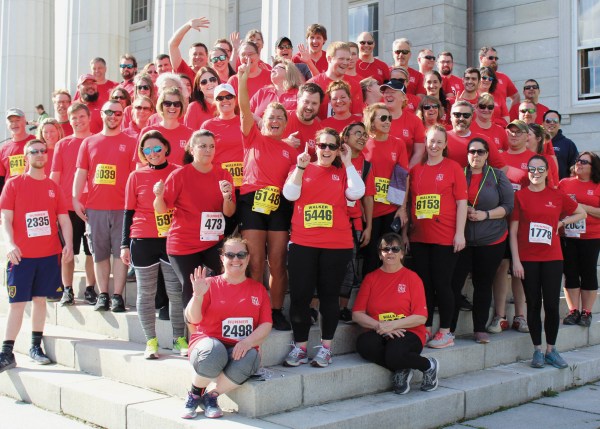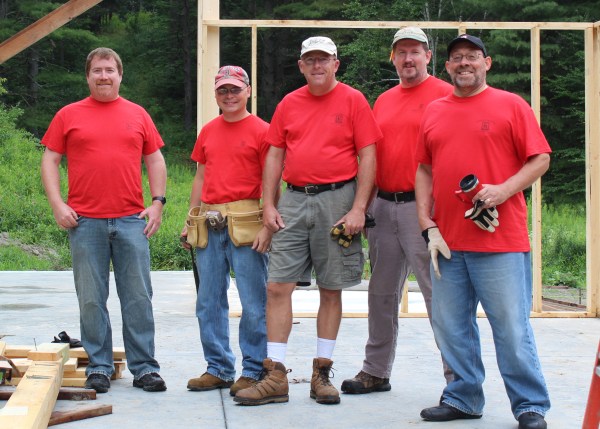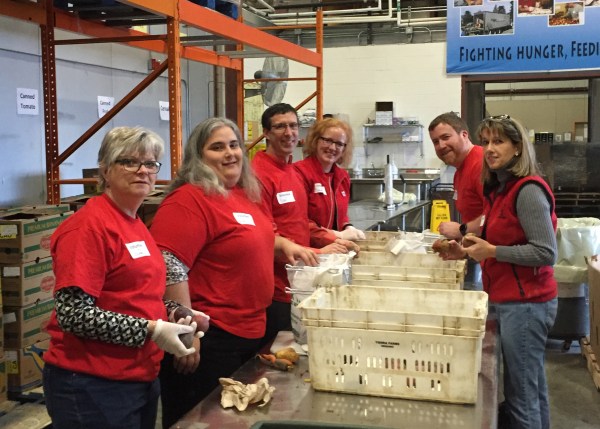A Conversation with Daniel C. Bridge – The 2023 Insurance Professional of the Year
Daniel Bridge
As Board Chair, President, and CEO of Vermont Mutual Insurance Group, Daniel Bridge has dedicated over 35 years to the New England insurance industry. Recognized for steering Vermont Mutual to stellar financial success and philanthropic involvement with the creation of the Charitable Giving Fund, Dan’s achievements have earned widespread recognition and respect over the course of his career.
This was no more apparent than during an award luncheon at the Intercontinental Hotel in Boston on Friday, October 13, when over 550 industry professionals from all over the region came out to celebrate Mr. Bridge as the 2023 Insurance Library Association’s Insurance Professional of the Year.
Despite his demanding schedule, he graciously agreed to provide this interview, reflecting his passionate commitment to the insurance industry and the people who work in it.
First off, could you tell us what it means to you to be named this year’s Insurance Professional of the Year?
Yes, it is always quite an honor to be recognized by your industry peers, and in many ways, I’m humbled and surprised by this recognition, as many of the past recipients have been friends, colleagues, and competitors throughout my career. Most of all, I’m proud of what this acknowledgment means for Vermont Mutual. Only a couple of times has this distinction made its way outside Massachusetts (Sandy Parillo at Providence Mutual comes to mind), so I believe this really speaks to the impact the team at Vermont Mutual has in being a strong partner for independent agents and serving their clients in Massachusetts and beyond. While the personal recognition is nice, I really view this as a Vermont Mutual team award.
How did you first get into insurance? Could you please walk us through your career journey and most formative experiences on the road to leading Vermont Mutual today?
Like many, I started by accident, but I was intentional in my moves once in the industry. I was working for the General Accounting Office in Washington, DC, and was looking to get back to the Boston area. I responded to an internal auditor opening at Liberty Mutual (Ironically, that job referral was sent to me by a young lady who turned out to be my wife). In my 18 years at Liberty, I made several moves – from Corporate Finance to Personal Markets Operations to Marketing and into Underwriting, holding positions both in the home office and the field. The career progression I had with Liberty was a bit more calculated or less accidental than my arrival into insurance. In 2003, I was recruited to OneBeacon in Boston and held a Regional President position for about five years. When the White Mountain Group acquired and repositioned Commercial Union. I left OneBeacon and did some consulting work for my only client, Vermont Mutual, who wanted someone to evaluate whether they should enter the personal auto market in Massachusetts under the new Managed Competition environment.
Not wanting to spend time looking for successive consulting opportunities, I got Vermont on an implementation path and went to work for Hanover Insurance as Vice President of State Management. About eight months into the Hanover experience, Tom Tierney and Bill Catto called to discuss being part of their succession plan at Vermont Mutual, an offer too good to turn down.
Likely due to my competitive nature and athletic background, the positions I found most challenging and rewarding were those where I had Profit and Loss responsibility for a region, division, or now a whole organization. Those roles had a specific scorecard to measure your wins and losses.
What first sparked your interest in insurance and led you down this career path to becoming CEO of Vermont Mutual?
It was not so much an interest in insurance that motivated my career path but rather the fundamental approach of being good at what you are doing each and every day and looking for additional learning opportunities and challenges. That approach provided me with some great and rewarding opportunities that led me to my current role at Vermont Mutual.
After 35 years of experience in the insurance industry, what would you say were some of the biggest lessons you learned early in your career that still guide you today as a leader?
Collaboration results in better decision-making. Surround yourself with great people. Don’t be afraid to admit you’re not the smartest one in the room or on a particular subject. Treat others as you would be treated. Leading is different than managing. Humility is a respected characteristic. Mistakes happen. Learn from them – no one bats 1,000.
Here is my quick story about humility and equality. The first thing I did on my first morning as company President was to walk outside with our Facilities employee and have him take down the reserved parking signs for the officers. We aimed for a “none of us is as strong as all of us” culture. If you arrive at the office early, you deserve the best parking spot.
Under your leadership, Vermont Mutual has consistently been recognized as one of the most secure, reliable, and top-performing insurance companies. To what do you attribute this success? What principles or philosophies have been key to this success, in your opinion?
Vermont Mutual had financial success prior to my arrival, but as my predecessors would admit, it was internally focused in an industry that was changing at a much faster pace. On day one, Mark McDonnell and I outlined and simplified our priorities that continue to be embraced by the team: (1) Strong Financial results remain our top priority; (2) None of us is as strong as all of us; (3) Modernization is a priority; (4) Data-driven decisions are usually better decisions; and (5) They call it “work” for a reason, but with an emphasis on employee work/life balance.
While strong financials give us flexibility and strength, building and maintaining a strong culture has been equally important.
Vermont Mutuals first office from 1828 to 1832 located on the same parcel of land the present office is located
Vermont Mutual office located on State Street Montpelier VT on same location where first office stood in 1828
The American Agency System has been a core distribution model for the P&C industry. What is your perspective on its continued role and viability looking ahead?
I believe the best way for consumers to purchase what can be complicated insurance protection is through the choice and counsel from an independent insurance agent. In the Northeast, we have a more favorable distribution through the agency system, and the only place you can get a Vermont Mutual policy is through a local independent agent. I have no doubt the agent distribution will continue to evolve but remain strong.
How do you see technology evolving the customer experience in insurance? How is Vermont Mutual leveraging technology to innovate?
Technology has improved the customer experience and will continue to do so, from digital billing and policy transactions and paperless solutions to easier access to information. Advancements also allow for more accurate pricing and loss mitigation through things like sensor technology. All this is good for companies and consumers, but necessary advice and counsel for complex purchases and claim handling is a reason for this to remain a people business.
Climate change is influencing catastrophe trends and modeling. How is Vermont Mutual responding to better understand and manage climate-related risks?
There is no denying that climate change is having a significant impact on weather across the globe, with events that are more frequent and more severe. In the past year alone, Vermont experienced the coldest day on record and generational flooding across the state (rendering our home office inoperable until mid-2024).
Our knowledge relative to the impacts of climate change is really in its infancy in what is a largely unpredictable problem thus far. With insurance losses increasing, we need to find ways to better protect consumers from loss with things like improved business codes and more resilient home products, sensor technology to provide advance warnings of potential loss, and education on how to mitigate loss. Similarly, we need to take steps at the insurer level to ensure companies can withstand catastrophic losses and continue to serve the market following the losses. To that end, we need to better understand and segment risks, ensure adequate pricing across the risk spectrum, have appropriate underwriting guidelines that protect the consumer and the company, and work with our reinsurance brokers and partners to have appropriate levels of reinsurance at reasonable costs.
We used to focus on the 1 in 250-year hurricane as a top concern. Secondary perils, such as the freeze event this past winter, are more likely, easier to visualize, and could happen multiple times in a season and can significantly impact earnings and surplus. These are now of equal concern.
The homeowners insurance market is facing challenges lately, as noted in a recent AM Best report. What is your perspective on the current dynamics and outlook for this product line?
While I agree there are challenges in the homeowner line of business, the challenges are not only with property insurance, nor is the insurance industry alone in its challenges. Coming out of a worldwide pandemic changed the economic landscape completely, with supply chain issues and employment issues followed by historic inflation and the hardening of the property reinsurance market. At the same time, climate change has increased the frequency and severity of weather-related losses.
The cost to insure property, automobiles, business, etc., has spiked rather quickly with inflation and other economic drivers, and an insurer’s ability to get prices aligned with these increased costs is an 18-24 month process. We are in the middle of premiums, not keeping pace with loss costs in our business. My estimation is we are about halfway through this as increased premiums move toward meeting the increased loss trends. While policyholders will see their insurance costs rise, it is important that they have enough coverage in the event of a loss and that their insurance company generates effective returns for the risk they take.
There really is a bit of a perfect storm in our industry with inflation, climate, return to work, hardened reinsurance, and volatile investments all happening at the same time. In our business, things can turn bad quickly, but recovery takes time.
Insurtech innovation is accelerating across the industry. How do you see technology impacting Vermont Mutual’s strategy and operations in the years ahead?
We strive to keep pace with technology and innovation that will improve customer experience and operations and have implemented several solutions. I believe we successfully avoid the temptation of innovation for innovation’s sake and really look at what problems we need to solve and whether innovation can help us solve those problems.
How has Vermont Mutual navigated various market cycles and disruptions throughout your time with the company? What lessons has this taught you?
I’ll let you know about this. We are undoubtedly in the most challenging insurance environment in my nearly 40 years in insurance and have been disciplined in our reaction to the challenges, but the jury is still out as to when our industry will emerge from this, as things like climate and inflation are out of our control. There will be lots of lessons coming from this current disruption, as for most in our industry, this is their first experience with a hard market. In the long run, they will be better prepared because of it.
In our 195-year history, we’ve seen our share of market cycles, just not for some time. Ironically, I was cleaning out old papers the other day and came across a mortgage statement from decades ago. My interest rate on the mortgage was 10.375%. We made it through those times just fine, and this, too, shall pass.
Where do you see the biggest opportunities for growth and expansion at Vermont Mutual moving forward?
Vermont Mutual tends to focus on the products and territories that we know well, doing business with the agency partners we know and respect. We have successfully grown our business without allocating capital to new markets and have worked on enhancing our current product line over time. In the early 90’s, we wrote business up and down the East Coast and west to Tennessee. Clearly, our move back to a northeast insurer has served us well as we’ve grown nearly tenfold operating with our commitment to a smaller geography and deeper relationships.
What is your vision for the future of Vermont Mutual as you lead the company forward in this rapidly evolving industry landscape?
Our current vision is very short-term term, as we need to weather the current environment and see profit return to our historical averages. More long term is a need to be sure we are in a position of strength with all the new agency owners resulting from the M&A activity of the last few years.
We will work hard to manage costs in our business to keep insurance coverage affordable for policyholders, and much of that will be gained through technology advancements.
You established the Vermont Mutual Charitable Giving Fund in 2014, which has granted over $4 million to local communities. Why was giving back in this way important to you and Vermont Mutual?
With the creation of the Charitable Giving Fund, we are quite simply fulfilling our community obligations as a significant and successful employer in Vermont and have the ability to extend these contributions to organizations and individuals in need throughout our marketing territories. I’m very proud of how our giving has evolved since 2014, but we do so because it is simply the right thing to do.
 All of the Vermont Mutual Employees Participating in the Corporate Cup
All of the Vermont Mutual Employees Participating in the Corporate Cup Participating in the Corporate Cup
Participating in the Corporate Cup Working with Habitat for Humanity
Working with Habitat for Humanity Volunteering at a Community Food Bank
Volunteering at a Community Food Bank
What advice would you give someone interested in a career on the business side of insurance today?
You’ll obviously find that those in our business came into insurance by accident rather than by intent, but what we’ve found is this business provides tremendous opportunity across many disciplines: Claims, Underwriting, Finance, Marketing, Actuarial and Analytics, Technology, Human Resources, Legal and is filled with tremendous people to work and network with.
As an industry, we need to overcome the bit of an identity crisis we have because there are rewarding opportunities with a number of great companies that can make for a great career.
As someone entering insurance, or any other field for that matter, they should make every opportunity (both good and not so good) and every conversation a learning experience and reach outside their own functional area to gain additional insight and development. It improves your skillset and your candidacy for future opportunities.
After decades of experience, what are your perspectives on how the P&C insurance industry needs to adapt to remain competitive and relevant for customers in the future?
The insurance industry has come a long way in the past decade, making complex insurance easier to understand and more transparent with consumers. Much of this involved digital transformations, making the purchase, policy changes, bill paying, and claim handling easier for policyholders. Our industry will continue to move in that direction as technology allows.
We’ve made great strides in utilizing data and analytics in our decision-making. That will continue at an aggressive pace.
With the unknowns surrounding climate change and their increasing occurrences and costs, we need to find solutions to prevent or mitigate loss, accurately price for what appears to be the new normal, and do our part to reduce global warming and carbon footprints.
Insurance has been the backbone of economies for centuries and will continue to serve the fundamental role of rebuilding when unfortunate losses occur. I have no doubt insurance will be relevant and competitive for the next few centuries as the need for insurance protection is so great.
I am excited and encouraged by how quickly our industry now moves to address the challenges of our business and the needs of consumers. This is no longer a stereotypically slow-moving industry, and I’m thrilled to be a part of it.
Would you have any other piece of advice or wisdom you would like to share with our readers?
Data will tell us there is something like 400,000 insurance professionals reaching retirement age in the next several years. It is an opportune time to get into a diverse industry and begin a rewarding career. We should all take on the personal challenge of bringing someone new into our business.
Thank you so much for taking the time to give our readers insight into your career and the business philosophy that led you to be Insurance Person of the Year for 2023.
You’re welcome.




